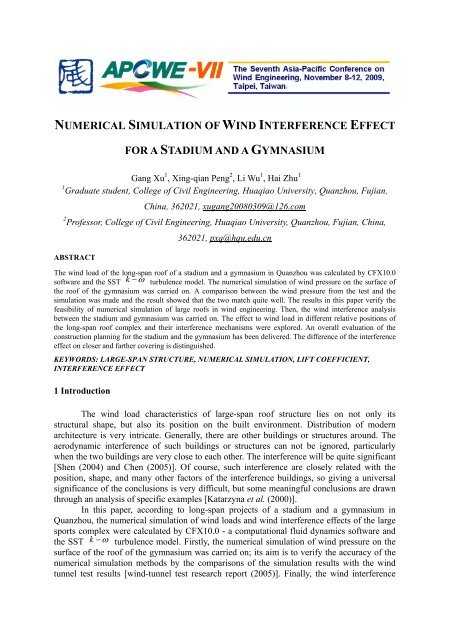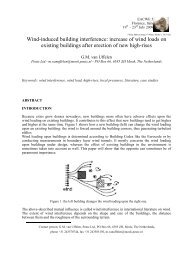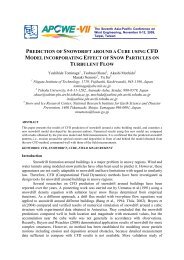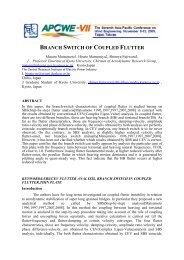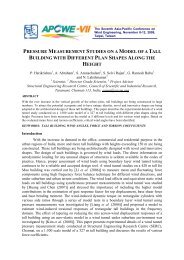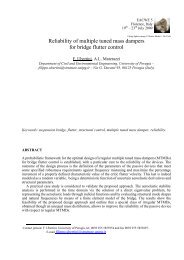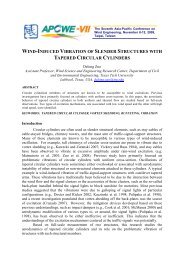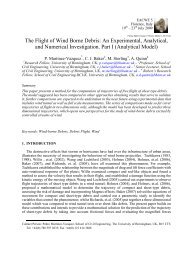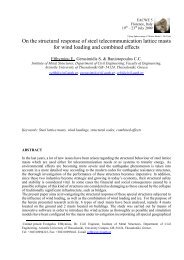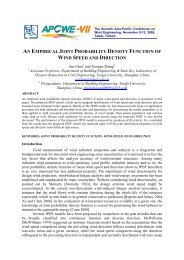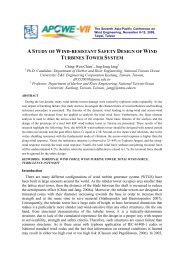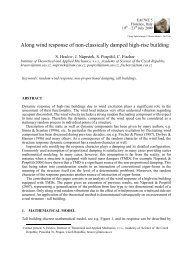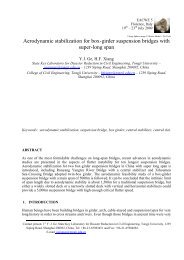numerical simulation of wind interference effect for a stadium and a ...
numerical simulation of wind interference effect for a stadium and a ...
numerical simulation of wind interference effect for a stadium and a ...
You also want an ePaper? Increase the reach of your titles
YUMPU automatically turns print PDFs into web optimized ePapers that Google loves.
NUMERICAL SIMULATION OF WIND INTERFERENCE EFFECT<br />
FOR A STADIUM AND A GYMNASIUM<br />
Gang Xu 1 , Xing-qian Peng 2 , Li Wu 1 , Hai Zhu 1<br />
1 Graduate student, College <strong>of</strong> Civil Engineering, Huaqiao University, Quanzhou, Fujian,<br />
China, 362021, xugang20080309@126.com<br />
2 Pr<strong>of</strong>essor, College <strong>of</strong> Civil Engineering, Huaqiao University, Quanzhou, Fujian, China,<br />
ABSTRACT<br />
362021, pxq@hqu.edu.cn<br />
The <strong>wind</strong> load <strong>of</strong> the long-span ro<strong>of</strong> <strong>of</strong> a <strong>stadium</strong> <strong>and</strong> a gymnasium in Quanzhou was calculated by CFX10.0<br />
s<strong>of</strong>tware <strong>and</strong> the SST k − ω turbulence model. The <strong>numerical</strong> <strong>simulation</strong> <strong>of</strong> <strong>wind</strong> pressure on the surface <strong>of</strong><br />
the ro<strong>of</strong> <strong>of</strong> the gymnasium was carried on. A comparison between the <strong>wind</strong> pressure from the test <strong>and</strong> the<br />
<strong>simulation</strong> was made <strong>and</strong> the result showed that the two match quite well. The results in this paper verify the<br />
feasibility <strong>of</strong> <strong>numerical</strong> <strong>simulation</strong> <strong>of</strong> large ro<strong>of</strong>s in <strong>wind</strong> engineering. Then, the <strong>wind</strong> <strong>interference</strong> analysis<br />
between the <strong>stadium</strong> <strong>and</strong> gymnasium was carried on. The <strong>effect</strong> to <strong>wind</strong> load in different relative positions <strong>of</strong><br />
the long-span ro<strong>of</strong> complex <strong>and</strong> their <strong>interference</strong> mechanisms were explored. An overall evaluation <strong>of</strong> the<br />
construction planning <strong>for</strong> the <strong>stadium</strong> <strong>and</strong> the gymnasium has been delivered. The difference <strong>of</strong> the <strong>interference</strong><br />
<strong>effect</strong> on closer <strong>and</strong> farther covering is distinguished.<br />
KEYWORDS: LARGE-SPAN STRUCTURE, NUMERICAL SIMULATION, LIFT COEFFICIENT,<br />
INTERFERENCE EFFECT<br />
1 Introduction<br />
The <strong>wind</strong> load characteristics <strong>of</strong> large-span ro<strong>of</strong> structure lies on not only its<br />
structural shape, but also its position on the built environment. Distribution <strong>of</strong> modern<br />
architecture is very intricate. Generally, there are other buildings or structures around. The<br />
aerodynamic <strong>interference</strong> <strong>of</strong> such buildings or structures can not be ignored, particularly<br />
when the two buildings are very close to each other. The <strong>interference</strong> will be quite significant<br />
[Shen (2004) <strong>and</strong> Chen (2005)]. Of course, such <strong>interference</strong> are closely related with the<br />
position, shape, <strong>and</strong> many other factors <strong>of</strong> the <strong>interference</strong> buildings, so giving a universal<br />
significance <strong>of</strong> the conclusions is very difficult, but some meaningful conclusions are drawn<br />
through an analysis <strong>of</strong> specific examples [Katarzyna et al. (2000)].<br />
In this paper, according to long-span projects <strong>of</strong> a <strong>stadium</strong> <strong>and</strong> a gymnasium in<br />
Quanzhou, the <strong>numerical</strong> <strong>simulation</strong> <strong>of</strong> <strong>wind</strong> loads <strong>and</strong> <strong>wind</strong> <strong>interference</strong> <strong>effect</strong>s <strong>of</strong> the large<br />
sports complex were calculated by CFX10.0 - a computational fluid dynamics s<strong>of</strong>tware <strong>and</strong><br />
the SST k − ω turbulence model. Firstly, the <strong>numerical</strong> <strong>simulation</strong> <strong>of</strong> <strong>wind</strong> pressure on the<br />
surface <strong>of</strong> the ro<strong>of</strong> <strong>of</strong> the gymnasium was carried on; its aim is to verify the accuracy <strong>of</strong> the<br />
<strong>numerical</strong> <strong>simulation</strong> methods by the comparisons <strong>of</strong> the <strong>simulation</strong> results with the <strong>wind</strong><br />
tunnel test results [<strong>wind</strong>-tunnel test research report (2005)]. Finally, the <strong>wind</strong> <strong>interference</strong>
The Seventh Asia-Pacific Conference on Wind Engineering, November 8-12, 2009, Taipei, Taiwan<br />
analysis between the <strong>stadium</strong> <strong>and</strong> gymnasium was carried on. The <strong>effect</strong> to <strong>wind</strong> load in<br />
different relative positions <strong>of</strong> the long-span ro<strong>of</strong> complex <strong>and</strong> their <strong>interference</strong> mechanisms<br />
were explored. An overall evaluation <strong>of</strong> the construction planning <strong>for</strong> the <strong>stadium</strong> <strong>and</strong> the<br />
gymnasium has been delivered.<br />
2 The CFD <strong>numerical</strong> <strong>simulation</strong> <strong>of</strong> the average <strong>wind</strong> pressure <strong>and</strong> data processing<br />
2.1 Numerical <strong>simulation</strong> <strong>and</strong> geometric trellis<br />
The large cross-building complex in Quanzhou is composed by the <strong>stadium</strong> (open<br />
cantilevered structure) <strong>and</strong> the gymnasium (closed structure). The distance between the<br />
<strong>stadium</strong> <strong>and</strong> the gymnasium is about 30m. The overall layout <strong>of</strong> <strong>stadium</strong> is made <strong>of</strong> an oval<br />
shell <strong>and</strong> a semi-cylindrical shell structure. The plane is uni-axial symmetry oval, the long<br />
axis is 218m <strong>and</strong> the short axis is 109.8m. The height <strong>of</strong> the highest ro<strong>of</strong> is 32.5m. The<br />
structure <strong>of</strong> the gymnasium is novel <strong>and</strong> unique. The overall layout <strong>of</strong> the gymnasium is<br />
composed by four independent cantilevered ro<strong>of</strong>s. The style <strong>of</strong> the gymnasium is curved<br />
reticulated shell structure with the distance between east <strong>and</strong> west is about 92m, north <strong>and</strong><br />
south is about 220m. The height <strong>of</strong> the ro<strong>of</strong> is 45.5m with a largest span <strong>of</strong> 48m. The model<br />
position, <strong>wind</strong> direction <strong>and</strong> the layout <strong>of</strong> measuring point <strong>of</strong> <strong>numerical</strong> <strong>simulation</strong> model are<br />
shown in Figure 1. In this paper, the world's leading computational fluid dynamics s<strong>of</strong>tware<br />
CFX10.0 is selected to do the calculation. The full-scale model <strong>of</strong> the <strong>stadium</strong> is established<br />
according to the actual construction plans, neglecting the torch column ancillary components,<br />
the final domain <strong>for</strong> calculating is 6000m × 4000m × 250m by calculated many times, basin<br />
set to meet the blocking probability is less than 3% <strong>of</strong> the requirements under the valley<br />
<strong>stadium</strong> model front 1/3, the entire computational domain is divided into a domain I <strong>and</strong><br />
domain II, the region is sufficient to simulate the whole atmospheric environment <strong>of</strong> the<br />
building. The non-structural hexahedral grid is used in domain I with 408,744 unstructured<br />
hexahedral elements divided. The 1,108,692 tetrahedral units <strong>and</strong> hexahedral elements <strong>of</strong><br />
non-slip near the wall are divided in domain II, the total <strong>of</strong> elements are 1,517,436 units. The<br />
model grid is shown in Figure2.<br />
Fig1. Model position, <strong>wind</strong> direction<br />
<strong>and</strong> the layout <strong>of</strong> measuring point<br />
Fig2. The trellis <strong>of</strong> a <strong>stadium</strong> <strong>and</strong> a gymnasium<br />
2.2 The physical model <strong>of</strong> turbulence<br />
The Reynolds stress model is used to calculate <strong>and</strong> the near wall function is used to<br />
simulate the complex flow phenomenon near the wall. The Reynolds stress model is a closed<br />
equation which includes 11 partial differential equations that consist <strong>of</strong> the average<br />
movement <strong>of</strong> three momentum equations <strong>and</strong> a continuity equation, six Reynolds stress<br />
equations <strong>and</strong> an ω equation [B. P. Hoxey et al. (1997)].<br />
2.3 Boundary Conditions
The Seventh Asia-Pacific Conference on Wind Engineering, November 8-12, 2009, Taipei, Taiwan<br />
Inlet: the <strong>wind</strong> speed [Huang (2002)]:<br />
Z<br />
(<br />
α<br />
U Z<br />
= U<br />
0<br />
, which 0<br />
Z<br />
0<br />
)<br />
Z is the reference<br />
height <strong>and</strong>U 0<br />
is <strong>wind</strong> speed <strong>of</strong> reference height, Z<br />
0<br />
=200m <strong>and</strong> U<br />
0<br />
=14m/s in accordance<br />
with the <strong>wind</strong> tunnel tests method B-type surface roughness coefficient <strong>of</strong> 0.16 [Richartson et<br />
al. (1997)], the turbulence intensity in Inlet, when Z ≤ 5m, I<br />
z<br />
=0.23; when 5m
The Seventh Asia-Pacific Conference on Wind Engineering, November 8-12, 2009, Taipei, Taiwan<br />
compared, considering the length, the paper presents the ro<strong>of</strong> block <strong>wind</strong> pressure coefficient<br />
deduced from <strong>numerical</strong> <strong>simulation</strong> under the <strong>wind</strong> direction <strong>of</strong> 0 <strong>and</strong> 90 degrees. The ro<strong>of</strong><br />
block <strong>wind</strong> pressure coefficient deduced from the test <strong>and</strong> the <strong>numerical</strong> <strong>simulation</strong><br />
respectively under the <strong>wind</strong> direction <strong>of</strong> 0 <strong>and</strong> 90 degree are in fig 3.<br />
Fig3.a tested at 0 ° Fig 3.b simulated at 0 °<br />
Fig3.c tested at 90 ° Fig 3.d simulated at 90 °<br />
Figure3. The <strong>wind</strong> pressure coefficient <strong>of</strong> composition <strong>for</strong>ce <strong>of</strong> the coving ro<strong>of</strong> block<br />
tested & simulated at some <strong>wind</strong> direction<br />
As can be seen from the fig, as regards the more complex geometry <strong>and</strong> large-span<br />
cantilevered ro<strong>of</strong> structure <strong>of</strong> the <strong>stadium</strong>, the <strong>numerical</strong> <strong>simulation</strong> with the experimental<br />
results is still relatively close, with an average error <strong>of</strong> about 33 percent in the overall<br />
accuracy which could satisfy the project accuracy requirement basically. The average error in<br />
0 <strong>and</strong> 90 degree are 33.28% <strong>and</strong> 33.65% respectively. Since the complex geometry <strong>of</strong> the<br />
<strong>stadium</strong> <strong>and</strong> gymnasium, <strong>numerical</strong> modeling <strong>of</strong> the <strong>wind</strong> load value is difficult, <strong>and</strong> the<br />
computer's computing power is limited, so the number <strong>of</strong> the grid could not be demarcated<br />
fine enough, what’s more, the ro<strong>of</strong> block demarcating error, boundary conditions the entrance<br />
<strong>of</strong> the <strong>wind</strong> pr<strong>of</strong>ile, roughness, etc. can not be completely coincide with the <strong>wind</strong> tunnel test<br />
environment, so there are some differences compared to the <strong>wind</strong> tunnel test, such as the<br />
vortex <strong>and</strong> separation around the construction objects generated by fluid, leading more<br />
difficult in <strong>numerical</strong> <strong>simulation</strong>. In general, the trend between the result <strong>of</strong> the <strong>numerical</strong><br />
<strong>simulation</strong> <strong>and</strong> the result <strong>of</strong> the <strong>wind</strong> tunnel test is generally the same. The <strong>numerical</strong>
The Seventh Asia-Pacific Conference on Wind Engineering, November 8-12, 2009, Taipei, Taiwan<br />
<strong>simulation</strong> value is greater than the <strong>wind</strong> tunnel test on the <strong>wind</strong>ward edge, trail edge <strong>and</strong> the<br />
corner. The two results basically inosculate <strong>and</strong> the <strong>simulation</strong> result is feasible.<br />
3.2 The gymnasium to the <strong>stadium</strong> aerodynamic disturbance<br />
It can be seen from the position <strong>of</strong> the <strong>stadium</strong> <strong>and</strong> the gymnasium that the<br />
gymnasium will have a greater aerodynamic disturbance to the east <strong>and</strong> west cantilevered<br />
ro<strong>of</strong>. The paper mainly selects the east cantilevered ro<strong>of</strong> <strong>interference</strong> <strong>effect</strong>s to carry on the<br />
analysis. The results from the <strong>numerical</strong> <strong>simulation</strong> <strong>of</strong> the <strong>stadium</strong> itself <strong>and</strong> both are<br />
analyzed, the lift coefficients <strong>of</strong> the east cantilevered ro<strong>of</strong> under different <strong>wind</strong> directions are<br />
worked out. The lift coefficients <strong>of</strong> <strong>wind</strong> pressure <strong>of</strong> the upper surface <strong>and</strong> the under surface<br />
are in Fig 4, the total lift coefficients <strong>of</strong> <strong>wind</strong> pressure are in Fig 5. Line-a shows no disturbed<br />
case <strong>and</strong> line-b shows disturbed case.<br />
(1) The lift coefficient is smaller than that when the gymnasium did not exist. When<br />
the gymnasium is in the lower reaches, <strong>for</strong> that the lower reaches <strong>of</strong> gymnasium slowed the<br />
flow <strong>of</strong> <strong>wind</strong> to some extent, resulting in the sub-pressure becoming smaller, but the range <strong>of</strong><br />
variation is not wide, because the <strong>stadium</strong> do not have much <strong>effect</strong> on preventing the flow <strong>of</strong><br />
<strong>wind</strong> owing to the higher beam with overhanging. The lift coefficient is larger when the<br />
gymnasium is at the parallel position than that when the gymnasium did not exist. It mainly<br />
due to the funneling when the <strong>wind</strong> through them, the <strong>wind</strong> speed increased, resulting in the<br />
sub-pressure <strong>of</strong> the surface becoming larger. When the gymnasium is in the upper reaches,<br />
because the airflow is blocked by the gymnasium, the speed <strong>of</strong> the airflow will be reduced to<br />
a certain extent, while the airflow in the building is separated <strong>and</strong> reattached, the flow<br />
turbulence <strong>of</strong> the ro<strong>of</strong> the lower reaches become higher, the separation <strong>of</strong> the flow in the<br />
front ro<strong>of</strong> reduced, resulting in negative pressure becoming smaller, so the lift coefficient is<br />
smaller than that when the gymnasium did not exist.<br />
(2) To the lift coefficient <strong>of</strong> the <strong>wind</strong> pressure under the surface, when the<br />
gymnasium is in the lower reaches, the lift coefficient become larger, That explains that the<br />
lower reaches <strong>of</strong> gymnasium slowed the flow <strong>of</strong> <strong>wind</strong> to some extent ,resulting in the drive<br />
<strong>effect</strong> obvious, but the range <strong>of</strong> variation is not wide, because the east cantilever ro<strong>of</strong> is<br />
located in the wake zone <strong>of</strong> the west cantilever ro<strong>of</strong>, the upper <strong>and</strong> lower surface pressure are<br />
smaller; when the gymnasium is in the parallel position, as the Gap tube <strong>effect</strong>, the <strong>wind</strong><br />
speed increased, the rapid outflow <strong>of</strong> the <strong>wind</strong> reduced the negative pressure under the<br />
surface, resulting in the lift coefficient becoming small; when the gymnasium is the upper<br />
reaches, because the east coving is located in the wake zone <strong>of</strong> the <strong>stadium</strong>, the flow<br />
separated in the front <strong>of</strong> the gymnasium <strong>and</strong> attached to the east cantilever ro<strong>of</strong>, resulting in<br />
negative pressure under the surface becoming smaller, so the lift coefficient becomes smaller.<br />
(3) To the <strong>wind</strong> <strong>for</strong>ce, when the gymnasium is in the lower reaches, since the airflow<br />
is blocked by the <strong>interference</strong> <strong>of</strong> the gymnasium, the total lift <strong>for</strong>ce coefficient <strong>of</strong> gymnasium<br />
is little smaller than that when it does not have gymnasium. But cantilever ro<strong>of</strong> is higher, the<br />
flow blocked that is not obvious, so the lift coefficient on the surface <strong>and</strong> under the surface<br />
decreased slightly; when the gymnasium is in the parallel position, the total lift <strong>for</strong>ce<br />
coefficient <strong>of</strong> gymnasium is larger than that when it does not have gymnasium. The total lift<br />
<strong>for</strong>ce <strong>of</strong> the east cantilever ro<strong>of</strong> increased because the gap tube <strong>effect</strong> when the gymnasium is<br />
in the upper reaches, the total lift coefficient is smaller than that when the gymnasium did not<br />
exist. Due to the existence <strong>of</strong> the upper reaches <strong>of</strong> the gymnasium <strong>and</strong> the downstream flow,<br />
the lift coefficient <strong>of</strong> the east become smaller, in the 90 ° <strong>wind</strong> direction, the total lift <strong>for</strong>ce <strong>of</strong><br />
the east cantilever ro<strong>of</strong> is the largest.
The Seventh Asia-Pacific Conference on Wind Engineering, November 8-12, 2009, Taipei, Taiwan<br />
0.2<br />
0.1<br />
CF<br />
0<br />
0 30 60 90 120 150 180 210 240 270 300 330 360<br />
-0.1<br />
-0.2<br />
-0.3<br />
-0.4<br />
Wind direction<br />
-0.5<br />
a up b up a under b under<br />
CF<br />
0<br />
0<br />
-0.05<br />
30 60 90 120 150 180 210 240 270 300 330 360<br />
-0.1<br />
-0.15<br />
-0.2<br />
-0.25<br />
-0.3<br />
-0.35<br />
-0.4<br />
-0.45<br />
Wind direction<br />
a total <strong>for</strong>ce b total <strong>for</strong>ce<br />
Fig 4.The lift coefficients <strong>of</strong> <strong>wind</strong> pressure Fig 5.The total lift coefficients <strong>of</strong> <strong>wind</strong> pressure<br />
<strong>of</strong> the upper surface <strong>and</strong> the under surface <strong>of</strong> the upper surface <strong>and</strong> the under surface<br />
3.2 The <strong>stadium</strong> to the gymnasium aerodynamic disturbance<br />
In order to reflect the quantitative <strong>interference</strong> <strong>effect</strong> <strong>of</strong> the <strong>stadium</strong> to the gymnasium,<br />
<strong>interference</strong> factor IF is employed:<br />
C<br />
Pi<br />
IF = (4)<br />
CPi<br />
is the average <strong>wind</strong> pressure interfered <strong>and</strong> C PA<br />
is the average <strong>wind</strong> pressure<br />
non-interfered. The gymnasium is composed by the Training Hall <strong>and</strong> the Competition Hall,<br />
the middle set up a 90mm wide joints, the ro<strong>of</strong> block <strong>wind</strong> pressure coefficient <strong>of</strong> Training<br />
Hall is 1-15 <strong>and</strong> the ro<strong>of</strong> block <strong>wind</strong> pressure coefficient <strong>of</strong> Competition Hall is 16-62, the<br />
<strong>numerical</strong> <strong>simulation</strong> <strong>of</strong> the gymnasium <strong>and</strong> the <strong>stadium</strong> is analyzed respectively ,because the<br />
gymnasium <strong>and</strong> the <strong>stadium</strong> are central axis symmetrical structures, here only to analyze the<br />
0° ~ 90° <strong>and</strong> 270° ~ 360°, the ro<strong>of</strong> block <strong>interference</strong> factor <strong>of</strong> gymnasium is calculated<br />
under different <strong>wind</strong> direction, the ro<strong>of</strong> block <strong>interference</strong> factor distribution maps under<br />
different <strong>wind</strong> direction is shown in Figure 6.<br />
(1) At the 0° <strong>wind</strong> direction, the <strong>interference</strong> factor <strong>of</strong> ro<strong>of</strong> block 1-15<strong>of</strong> the training<br />
hall is larger, the maximum is 2, the biggest negative is -4, the geopolitical <strong>interference</strong> factor<br />
is smaller, most <strong>interference</strong> factors <strong>of</strong> the competition hall Ro<strong>of</strong> is about 1.2. Because the air<br />
flow accelerated in a passage between the <strong>stadium</strong> <strong>and</strong> the gymnasium, resulting in Gap tube<br />
<strong>effect</strong>, the ro<strong>of</strong> block 1-15 <strong>interference</strong> factor <strong>of</strong> the training hall is larger. The <strong>interference</strong><br />
<strong>effect</strong> is obvious near the <strong>stadium</strong>, the <strong>wind</strong> pressure <strong>of</strong> block 1 <strong>and</strong> 2 turned into negative<br />
<strong>and</strong> <strong>interference</strong> factor is negative too. As the ro<strong>of</strong> <strong>of</strong> Competition Hall ro<strong>of</strong> is far from the<br />
<strong>stadium</strong>, the <strong>interference</strong> factors <strong>of</strong> ro<strong>of</strong> block 16-62 are smaller.<br />
(2) At the 45° <strong>wind</strong> direction, the <strong>interference</strong> factors <strong>of</strong> ro<strong>of</strong> block 1-15 <strong>of</strong> the<br />
training hall is smaller, the minimum is 0.48, the geopolitical <strong>interference</strong> factor is greater,<br />
the ro<strong>of</strong> block <strong>interference</strong> factor <strong>of</strong> the competition hall is smaller, most <strong>of</strong> the ro<strong>of</strong> block16<br />
-62 <strong>interference</strong> factors <strong>of</strong> the competition hall ’s Ro<strong>of</strong> is about 1.0 because <strong>of</strong> the existence<br />
<strong>of</strong> the <strong>stadium</strong> <strong>and</strong> the gymnasium is higher than the <strong>stadium</strong>, the flow blocked by the<br />
training hall <strong>and</strong> <strong>wind</strong> speed decreased, the <strong>wind</strong> pressure <strong>of</strong> the training hall ’s ro<strong>of</strong> reduces,<br />
so the <strong>interference</strong> factor is smaller.<br />
(3) At the 90° <strong>wind</strong> direction, the <strong>wind</strong> pressure trends <strong>of</strong> the gymnasium is similar to<br />
the 45° <strong>wind</strong> direction case, the ro<strong>of</strong> block 1-15 <strong>interference</strong> factor <strong>of</strong> training hall is smaller,<br />
the minimum is 0.20, <strong>and</strong> <strong>interference</strong> <strong>effect</strong> is more obvious, the ro<strong>of</strong> block <strong>interference</strong><br />
factor <strong>of</strong> Competition Hall is smaller <strong>and</strong> most <strong>of</strong> ro<strong>of</strong> block <strong>interference</strong> factor is about 1.<br />
(4) At the 270° <strong>wind</strong> direction, the ro<strong>of</strong> block 1-15 <strong>interference</strong> factor <strong>of</strong> the training<br />
hall is smaller, the minimum is 0.18, <strong>interference</strong> <strong>effect</strong>s are obvious, the geopolitical<br />
C<br />
PA
The Seventh Asia-Pacific Conference on Wind Engineering, November 8-12, 2009, Taipei, Taiwan<br />
<strong>interference</strong> factor is smaller, most <strong>of</strong> the <strong>interference</strong> factors <strong>of</strong> ro<strong>of</strong> block 1-62 <strong>of</strong> the<br />
competition hall is 0.8 ~ 1.0 <strong>of</strong> which the ro<strong>of</strong> block 22-32 is smaller, most <strong>interference</strong><br />
factors are about 0.6. Because <strong>of</strong> the <strong>stadium</strong> in the upper reaches <strong>of</strong> the gymnasium <strong>and</strong> its<br />
block the airflow, resulting in a significant shielding <strong>effect</strong>. The flow speed will be reduced<br />
to a certain extent, the <strong>wind</strong> pressure <strong>of</strong> the ro<strong>of</strong> reduce, so the <strong>interference</strong> factor is smaller.<br />
Since the competition hall in the wake flow district, the shielding <strong>effect</strong> is not very obvious,<br />
the <strong>wind</strong> pressure <strong>of</strong> competition hall is affected a little <strong>and</strong> the <strong>interference</strong> factor is bigger.<br />
(5) The shape <strong>and</strong> position <strong>of</strong> the interfere affected the average <strong>wind</strong> pressure <strong>of</strong> the<br />
tested buildings, the <strong>stadium</strong> <strong>and</strong> gymnasium is a central axis symmetrical streamlined<br />
structure <strong>and</strong> the covering <strong>of</strong> the gymnasium is higher then the <strong>stadium</strong> which is benefit to<br />
the <strong>wind</strong> load <strong>of</strong> the <strong>stadium</strong> <strong>and</strong> gymnasium. When the <strong>stadium</strong> is in the lower reaches <strong>of</strong><br />
the gymnasium, the flow blocked by the <strong>stadium</strong>, <strong>wind</strong> speed slows down, the <strong>wind</strong> pressure<br />
<strong>of</strong> gymnasium’s ro<strong>of</strong> reduces. When the <strong>stadium</strong> is in the upper reaches <strong>of</strong> the gymnasium,<br />
the gymnasium is blocked by the <strong>stadium</strong>, the <strong>wind</strong> pressure <strong>of</strong> gymnasium’s ro<strong>of</strong> reduces.<br />
Consequently, the architecture planning <strong>of</strong> the <strong>stadium</strong> <strong>and</strong> gymnasium is quite reasonable.<br />
3<br />
IF<br />
2<br />
1<br />
0<br />
1 3 5 7 9 11 13 15 17 19 21 23 25 27 29 31 33 35 37 39 41 43 45 47 49 51 53 55 57 59 61<br />
-1<br />
-2<br />
-3<br />
1.25<br />
1<br />
0.75<br />
0.5<br />
0.25<br />
IF<br />
-4<br />
-5<br />
0<br />
1 3 5 7 9 11 13 15 17 19 21 23 25 27 29 31 33 35 37 39 41 43 45 47 49 51 53 55 57 59 61<br />
Fig.a. 0 °ro<strong>of</strong> block 1-62 Fig.b. 45 °ro<strong>of</strong> block 1-62<br />
IF<br />
1.2<br />
1<br />
0.8<br />
0.6<br />
0.4<br />
0.2<br />
0<br />
1 3 5 7 9 11 13 15 17 19 21 23 25 27 29 31 33 35 37 39 41 43 45 47 49 51 53 55 57 59 61<br />
IF<br />
1<br />
0.9<br />
0.8<br />
0.7<br />
0.6<br />
0.5<br />
0.4<br />
0.3<br />
0.2<br />
0.1<br />
0<br />
1 3 5 7 9 11 13 15 17 19 21 23 25 27 29 31 33 35 37 39 41 43 45 47 49 51 53 55 57 59 61<br />
Fig.c. 90 °ro<strong>of</strong> block 1-62 Fig.d. 270 °ro<strong>of</strong> block 1-62<br />
Fig 6.The ro<strong>of</strong> block <strong>interference</strong> factor distribution <strong>of</strong><br />
gymnasium at some <strong>wind</strong> direction<br />
4 Conclusions<br />
In this paper the <strong>wind</strong> loads <strong>of</strong> the long-span ro<strong>of</strong> <strong>of</strong> the <strong>stadium</strong> <strong>and</strong> gymnasium in<br />
Quanzhou were calculated <strong>and</strong> the <strong>wind</strong> <strong>interference</strong> analysis between the <strong>stadium</strong> <strong>and</strong><br />
gymnasium was carried. Some conclusions are as follows:<br />
(1) The <strong>wind</strong> loads was studied comparatively by <strong>wind</strong> tunnel test <strong>and</strong> CFD<br />
<strong>simulation</strong> <strong>and</strong> the law <strong>of</strong> <strong>wind</strong> pressure distribution is similar. The results in this paper<br />
verify the feasibility <strong>of</strong> <strong>numerical</strong> <strong>simulation</strong> <strong>of</strong> large-span ro<strong>of</strong> buildings.<br />
(2) The <strong>stadium</strong> that in the upper reaches reduces the lift <strong>for</strong>ce <strong>of</strong> the approach<br />
cantilevered ro<strong>of</strong> <strong>of</strong> the gymnasium, increases the lift <strong>for</strong>ce when in parallel position, reduces<br />
the lift <strong>for</strong>ce when in the lower reaches.<br />
(3) The <strong>wind</strong> pressure <strong>of</strong> the <strong>stadium</strong>'s ro<strong>of</strong> is affected by the gymnasium. When the<br />
<strong>stadium</strong> is in the upper reaches <strong>of</strong> the gymnasium, the flow blocked by the <strong>stadium</strong>, the <strong>wind</strong><br />
pressure <strong>of</strong> gymnasium’s ro<strong>of</strong> reduces, shielding <strong>effect</strong> is not very obvious. When the
The Seventh Asia-Pacific Conference on Wind Engineering, November 8-12, 2009, Taipei, Taiwan<br />
<strong>stadium</strong> is in the lower <strong>of</strong> the gymnasium, the flow is reduced by the <strong>stadium</strong>, the <strong>wind</strong><br />
pressure <strong>of</strong> gymnasium in the training hall ro<strong>of</strong> reduces. When the <strong>stadium</strong> is in parallel<br />
position, the <strong>wind</strong> speed increases between the <strong>stadium</strong> <strong>and</strong> the gymnasium, gap tube <strong>effect</strong><br />
is obvious, the <strong>wind</strong> pressure <strong>of</strong> gymnasium’s ro<strong>of</strong> increases.<br />
(4) The shape <strong>and</strong> position <strong>of</strong> the complex affects the average <strong>wind</strong> pressure <strong>of</strong> the<br />
tested buildings, the <strong>stadium</strong> <strong>and</strong> gymnasium is a central axis symmetrical streamlined<br />
structure <strong>and</strong> the covering <strong>of</strong> the gymnasium is higher than the <strong>stadium</strong> which is benefit to<br />
the <strong>wind</strong> load <strong>of</strong> the <strong>stadium</strong> <strong>and</strong> gymnasium. Consequently, the architecture planning <strong>of</strong> the<br />
<strong>stadium</strong> <strong>and</strong> gymnasium is quite reasonable.<br />
Acknowledgements<br />
This research is supported by the following projects: the National Natural Science<br />
Foundation <strong>of</strong> China under Grant No. 50708040, the Fujian’s Science <strong>and</strong> Technology signal<br />
special project under Grant No. 2005YZ1016, the Xiamen’s Science <strong>and</strong> Technology<br />
university innovation project under Grant No. 3502Z20083039, the Quanzhou’s Science <strong>and</strong><br />
Technology planned project under Grant No. 2007G7.<br />
References<br />
Chen X. C. (2005), “the theoretical study <strong>and</strong> application <strong>of</strong> <strong>wind</strong>-induced response <strong>and</strong> equivalent <strong>wind</strong> load <strong>of</strong><br />
large-span ro<strong>of</strong> structure”, Zhejiang University doctoral dissertation.<br />
Huang B. C. (2002), “Wind Resistance Analysis theory <strong>and</strong> Application <strong>for</strong> Structure”, 2 rd Edition, Tongji<br />
University Press, Shanghai, 31-32.<br />
Kh<strong>and</strong>uri, ACStathopoulos <strong>and</strong> T.Bedard C. (1998), “Wind-induced <strong>interference</strong> <strong>effect</strong>s on Buildings-a review<br />
<strong>of</strong> the state-<strong>of</strong>-the-art ”, Engineering Structure, 20 (7), 617-630.<br />
Lin B. (2005), “The <strong>wind</strong> tunnel test <strong>and</strong> CFD <strong>numerical</strong> <strong>simulation</strong> <strong>of</strong> the <strong>wind</strong> load <strong>of</strong> Daqing Petroleum<br />
Institute gymnasium ro<strong>of</strong>”, Xi'an: the structure <strong>of</strong> the twelfth National Conference on Wind Engineering,<br />
724-730.<br />
Katarzyna Klemm,Wojciech Marks, Agnieszka J. Klemm. (2000), “Multicriteria optimization <strong>of</strong> the<br />
building arrangement with application <strong>of</strong> <strong>numerical</strong> <strong>simulation</strong>. Building <strong>and</strong> Environment, 35(1): 537-544.<br />
Richartson G.M., Hoxey R.P., Robertson A.P., Short L.J. (1997), “The silsoe structures Building Com- parisons<br />
<strong>of</strong> pressures measured at full scale <strong>and</strong> in two tunnels”, Journal <strong>of</strong> <strong>wind</strong> engineering <strong>and</strong> Industrial<br />
Aerodynamics, 72: 187~197.<br />
Shen G. H. (2004), “large-span ro<strong>of</strong> structure <strong>of</strong> <strong>wind</strong> resistance studies”, Zhejiang University doctoral<br />
dissertation.<br />
Suggestion <strong>of</strong> Japan. (1996), AIJ Recommendations <strong>for</strong> Loads on Buildings.<br />
<strong>wind</strong>-tunnel test research report. (2005), “The Civil Engineering State Key Laboratory <strong>of</strong> Disaster Prevention <strong>of</strong><br />
Tongji University”, The study <strong>of</strong> <strong>wind</strong> tunnel tests, <strong>wind</strong>-induced response <strong>and</strong> equivalent static <strong>wind</strong> load <strong>of</strong><br />
Quanzhou Straits Sports Center Stadium.


